BitMEX Review: Complete Exchange Overview!

BitMEX is a professional cryptocurrency derivatives exchange that offers up to 100x leverage and supports trading for cryptocurrencies. It is a go-to option for experienced traders looking for high volatility and volume, offering all the advanced tools required for trading.
There is no doubt that you would have heard of BitMEX (The Bitcoin Mercantile Exchange).
This is one of the most well-known Bitcoin future exchanges in the world and is the go-to exchange for advanced traders and speculators alike.
But, what is the real deal with BitMEX? Can it be trusted and is it a safe exchange to use?
In this BitMEX review, we will dig deep into this exchange and give you all the answers. We will also give you some hints and tips in order to avoid liquidations and make the most out of futures trading.
Bitmex 10% Discount
Overview
BitMEX was started in 2014 by former Citibank trader Arthur Hayes as well as Samuel Reed and Ben Delo. BitMEX was originally located in Hong Kong but is now headquartered in Seychelles.
The holding company is called HDR Global Trading Limited, which is registered in Seychelles. This is a structure that many Bitcoin-related businesses and exchanges tend to choose given the tax efficiency.
BitMEX is a margin trading exchange. This means that you will trade leveraged positions with coins placed on margin. Margin trading is not for all traders and can be really risky. This is especially true in the case of BitMEX where margins can run to 100 times.
One of the great advantages of margin trading is that it allows the trader to short the price of the cryptocurrency. This means that they can make money on the fall in the price of the asset by short selling it.
Another thing that distinguishes BitMEX from numerous other exchanges is that they do not accept Fiat deposits. You can only fund in Bitcoin and withdraw in Bitcoin.
BitMEX also differs from other larger cryptocurrency exchanges such as Binance in the fact that all positions are marked in Bitcoin. Although you can trade a margin position on altcoins, you profit will be in Bitcoin and you cannot withdraw these coins from the exchange.
So, BitMEX is an exchange for traders. Not investors who buy and hold.
Is BitMEX Safe?
Arguably one of the most important factors when you are choosing an exchange is the security procedures they implement
So, is BitMEX safe?
To this day, BitMEX has not suffered any hacks. This could be down to their advanced security practices, which you can read about in more detail on the BitMEX FAQ page. They break their exchange policies down by function:
Wallets
The wallets are secured with multi-signature deposits and withdrawals. This means that BTC from the exchange's cold stored wallets cannot be spent until the signatories (BitMEX partners) can authorise withdrawal.
They also use an external service to verify that all deposit addresses that are created on the system are those that are controlled by the founders. If they do not then all trading is halted.
For personal security, you have two-factor authentication should you want to make use of it. The hand-processed withdrawals is an extra layer of security should your account be compromised at any time.
System
The server infrastructure is secured by Amazon Web Services. They require multiple forms of authentication as well as hardware tokens.
Trading Engine
Apart from the threat that comes from external attackers, there is also a great deal of risk in running such a highly levered and voluminous trading platform.
This is why BitMEX has a number of policies in place in order to make sure that all of the orders are indeed matched. They run a risk check after any movement on the exchange and the moment that there is any discrepancy, trading is shut down.
Communication
For those traders who are extra cautious about their communication security, BitMEX offers the option to PGP encrypt the automated emails.
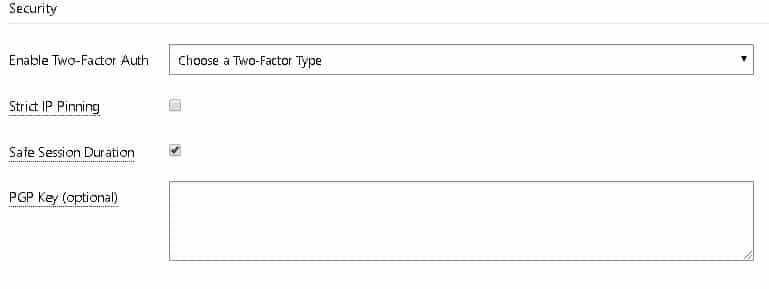
If this is something that you would like to do, then you will have to go to your account and insert your PGP public key into the form they present. Once this is completed, all emails that come from [email protected] will be encrypted.
Proof of Reserves
Given what has happened with FTX recently, exchanges are scrambling to prove that client funds are secure, safe, and that the companies are fully solvent. BitMEX is one of the early adopters of Proof-of-Reserves, the trending topic of the day.
According to Glassnode, Proof of Reserves (PoR) displays the assets held on-chain and matching liabilities held both on and off-chain. A number of exchanges have disclosed their on-chain addresses (but not liabilities) to Glassnode, including BitMEX.
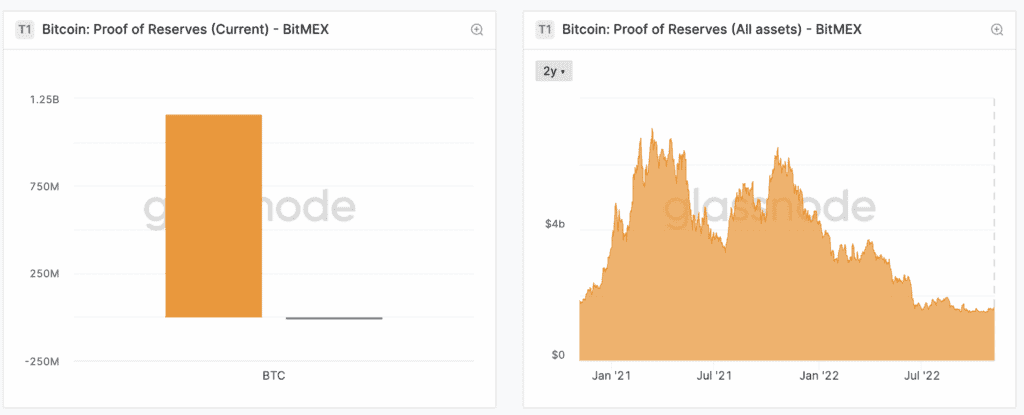
As early as Aug 2021, BitMEX investigated the feasibility of adopting PoR as part of their security measures. In a blog from around that time, not only were they considering PoR but also Proof of Liabilities. The idea is that when Proof of Reserves are greater than Proof of Liabilities, this means the exchange is solvent, ie able to process all withdrawals from clients if requested.
BitMEX also uses the Merkle Tree approach for its PoR scheme. Initially, it made the case for only publishing part of the tree in order to ensure anonymity with the user’s information. However, they then argued in their blog that "this makes the Merkle tree structure pointless and the exchange should use the list approach, however, adopting the tree provides flexibility, should the exchange wish to cease publication of the full list at some point.”
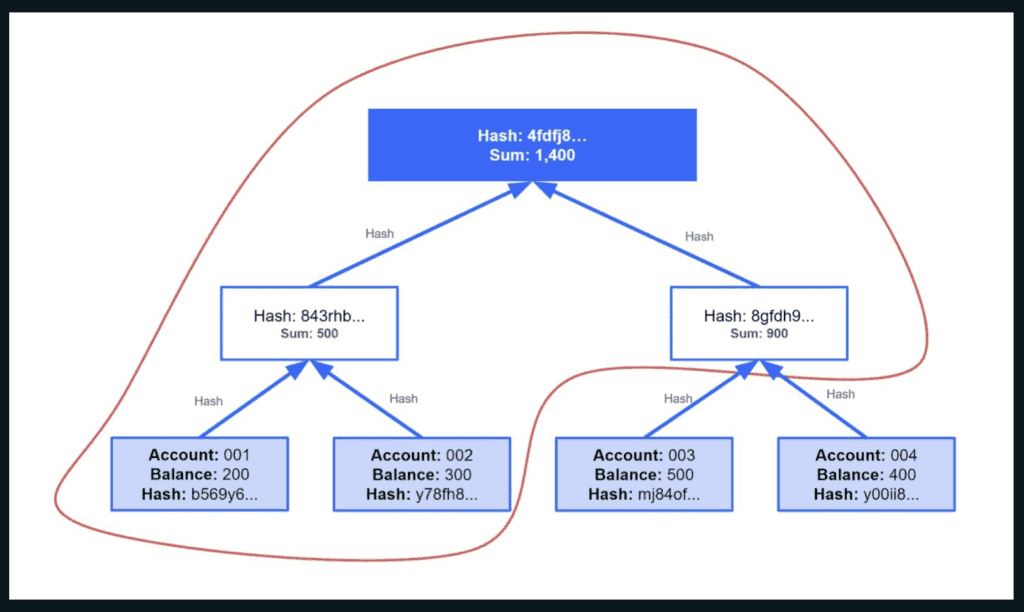
Oddly enough, they decided to “publish a basic list of [the] reserves […] contain[ing] all the Bitcoin we have under our custody on behalf of our clients”, as reported by Coindesk on Nov 10, 2022. Guess they did decide to take the easy route after all.
What to Look Out For
Based on the latest snapshot taken on Nov 22, 2022, BitMEX holds more Bitcoin than what is deposited with them.
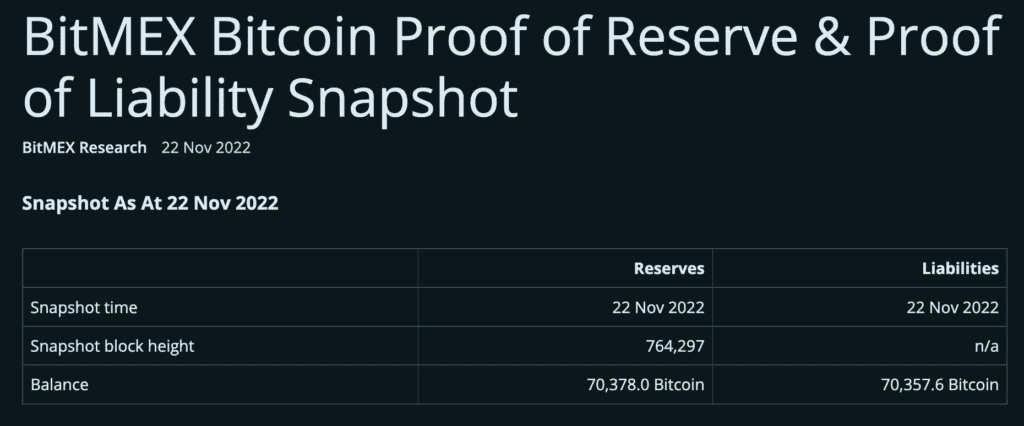
Similar to the one above, these holdings are only for bitcoin, unlike some of the other exchanges that also show proofs for ETH and other assets. However, support for these assets are scheduled in the near future.
Not only that, please bear in mind that these are snapshots, ie a moment frozen in time. What happens to the funds before and after the snapshots are taken is unclear. Unless audits are done in real-time on an up-to-the-minute basis, one can only rely on the integrity of the exchange.
It is still reassuring though, that of all the exchanges listed in the “Gold standard” section of Nic Carter’s PoR page, that BitMEX does their audits bi-weekly, the most of any exchanges. However, a small minus for the self-assessment part instead of being auditor-assisted. Can’t get too greedy, I suppose.
Crypto Asset Coverage
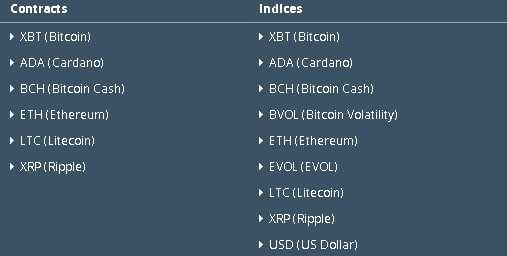
Given that BitMEX is a futures exchange, the only asset that you can trade in the spot market is Bitcoin. This is why when you take a look at the volume on Coinmarketcap, you will only see a figure for Bitcoin.
However, when it comes to the futures markets, BitMEX allows for you to trade 10 different cryptocurrency assets. These are given below:
Bitcoin (BTC), Dash (DASH), Ethereum (ETH), Ethereum Classic (ETC), Litecoin (LTC), Monero (XMR), Ripple (XRP), Tezos (TEZ), Zcash (ZEC) and Cardano (ADA).
Although BitMEX supports fewer coins than the likes of Bittrex and Poloniex, these are cryptocurrency margin trades and not the purchase of physical coins. It could be much harder to find the liquidity for the smaller-cap altcoin futures.
Perpetual Swaps vs. Futures
BitMEX has two types of derivative assets that you can trade. These are an instrument termed a "Perpetual Swap" and the plain vanilla futures.
What is a perpetual swap?
A perpetual swap is, quite simply, a future that does not have an expiry date. For those who do not know, futures are instruments that are settled sometime in the future. These are mostly settled every quarter and usually have an expiry price above the current spot.
A perpetual swap will merely be a future that is continually marked to market on a daily basis. In this manner, you can think of a perpetual swap in much the same way as spread betting or a Contract for Difference (CFD) works.
Don't let definitions trip you up though.
Trading a perpetual swap is just like trading the physical instrument at spot. The price that will be presented will be the spot price of the asset. Of course, your gains/losses will be magnified due to the leverage.
BitMEX Leverage
BitMEX is favoured by cryptocurrency traders worldwide because of the leveraged trading that you can employ. For example, in the case of their Bitcoin instruments, you have a maximum leverage of up to 100x.
Pro Tip ✔️: Leverage starts as low as 1x. Start small and work your way up at first! Using leverage is extremely risky, at the Coin Bureau, we do not recommend trading using high leverage.
Although that is the maximum leverage that one can employ with Bitcoin, the other assets will have a lower maximum leverage. This will be determined by the amount of initial margin that must be put up. Below are some of the max leverage numbers for other coins:
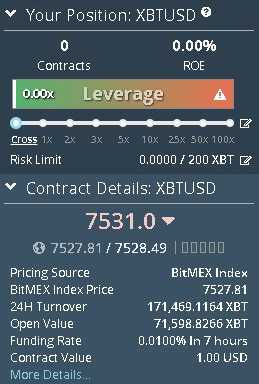
- Ripple (XRP): 20x
- Litecoin (LTC): 33x
- Ethereum (ETH): 50x
- Bitcoin Cash (BCH): 20x
- Cardano (ADA): 20x
- Ethereum Classic (ETC): 20x
- Monero (XMR): 25x
- ZCash (ZEC): 5x
When you are margin trading, there are two types that you can make use of: Isolated and Cross-Margin.
In the case of Isolated, you can select the amount of money in your wallet that should be used for a position after you have placed the order. The cross margin, on the other hand, will assume that all of the money that you have in your account is up for leverage.
Of course, it goes without saying that you should only use high leverage and cross-margin if you know what you are doing. Leverage is a double-edged sword and you can also find yourself taking out pretty quickly if you are on the wrong side of a trade.
This is due to infamous "margin calls".
In the case of BitMEX, these margin calls are automatic and will either draw on the funds that are in your account or they will liquidate your positions. This will happen whenever your position drops to the level of the maintenance margin.
BitMEX Fees
The trading fees at BitMEX work a little bit different given that you are trading leveraged instruments. You will have "maker" and "taker" fees. These essentially imply whether you are making an order or taking an order.
What does this mean?
Basically, when you are a taker, you are matching an order that is already on the order books. You are essentially removing liquidity by taking an order that is already on their books.
In the case of a maker, you are adding liquidity to the order books by placing a limit order that is away from the current price. This would be a buy limit order below the current price or a sell limit order above the current price.
At BitMEX, when you are adding liquidity to their books, they will pay you. This is why they are termed a rebate. BitMEX has a rather simple structure for its fees.
For Tezos and ZCash, the fees are:
- Maker fee (Rebate): 0%
- Taker fee: 0.25%
- Settlement fee: 0.25%
And for all of the other coins:
- Maker fee (Rebate): 0.075%
- Taker fee: 0.025%
- Settlement fee: 0.05%
In the case of hidden orders (more below) the fees that you will encounter differ slightly. When you place your hidden order, you will pay the taker fee until the complete order is done. Then, once it has been executed, you will be given the maker rebate.
When it comes to other fees, you will not have to pay anything to BitMEX to deposit or withdraw your funds. However, they will charge you a minimum network fee for your payments, so it makes sense to keep your transaction in larger tranches.
Registration and Trading
Before you can test out the platform, you have to sign up at BitMEX with an account. The signup process is relatively straightforward and you will only be required to provide an email.
So far, BitMEX does not require KYC documents from traders so it is possible to sign up anonymously. You are required to give a valid email, however, as you will need this to confirm your account and all the withdrawals etc.
BitMEX USA Registrations
If you are based in the United States you are probably wondering if you can trade at BitMEX?
The short answer is most probably no. BitMEX is an offshore unregulated futures exchange that does not have any licences from the SEC to offer these kind of services to US citizens.
Moreover, BitMEX is one of the few remaining exchanges that does not require their traders to complete KYC and identify themselves. This means that they cannot verify exactly who is trading on their platform.
This has resulted in numerous US-based clients creating accounts and trading on BitMEX.
Yes, this is against their T&Cs and BitMEX has been blocking US-based IPs from trading but this is not really an effective solution. We are all aware of VPN software that is able to hide the origins of your IP.
However, given the increased scrutiny of the SEC into other offshore brokerages and exchanges, BitMEX has begun shutting down accounts suspected of being US based. These have started with notable crypto traders:
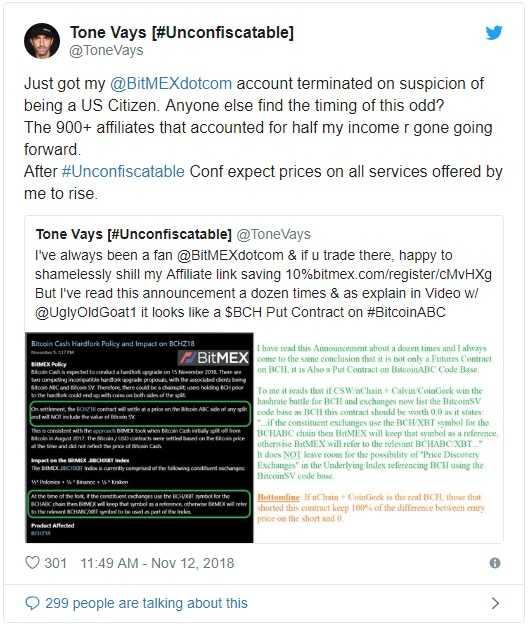
So, if you are a US-based trader, what does this mean for you?
Well, BitMEX is only likely to shut down your account if they do suspect you of being based in the US. So if you are still able to trade there anonymously, then they are unlikely to jump on it immediately.
Having said that, it is only a matter of time before it becomes impossible for US-based traders to use it on an ongoing basis. Exchanges are gradually moving to a more transparent status quo and many think that the days of anonymous exchange accounts are numbered.
If you are a US-based person with a BitMEX account, then you should exercise caution. You never know if there could come a day when the exchange institutes compulsory KYC and will request your docs.
If you are looking for an attractive alternative that does offer crypto margin trading to US-based clients then you could consider the likes of Kraken.
Trading Platform
It is time to head into the belly of the BitMEX beast.
That is the trading platform and technology. Given that the exchange was launched by Ex-investment bankers and traders, it is well known for having one of the most efficient "matching engines" around.
Let's take a deeper look…
Once you have confirmed your email and you have logged back into the website, you will be presented with the BitMEX trading platform. You have a list of all the instruments that you can trade at the top of the platform.
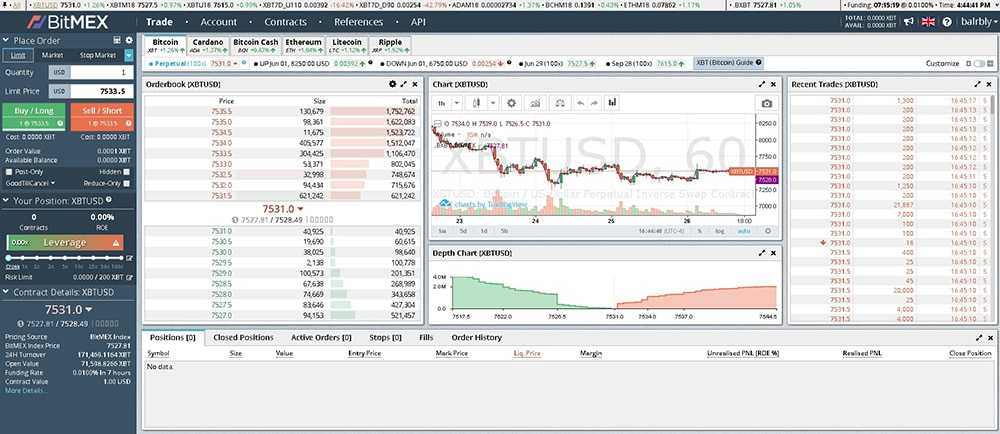
Once you select a particular instrument, then it will open up on that market. What you are presented with is pretty typical for a cryptocurrency exchange. You will have the order books, charts, recent orders and positions.
Something that is a bit more unique to BitMEX is the involved order form. This is obviously needed in order to select the desired leverage and order specifics.
Take Note✔️:You can move widgets around and alter the trading interface to suit your preferences
You can also expand the chart to full screen and make use of all the charting tools and analysis. BitMEX makes use of trading view charts which means that you will have access to most of the studies and indicators that you need.
Below all the charts in the image, you will also have all of the orders that you currently have. If you have a live limit order that you decide you would not like to be filled, then you can merely decide to cancel it from this order interface.
Trader's Tip?: There is an even more advanced layout that pro traders can enable in their dashboard
In terms of the trading engine itself, BitMEX uses software that is being used on Wall Street by high-frequency trading firms. It is written in kdb+.
Just to give you an idea of how fast the trading engine can execute orders, it is well known that kdb+ has a throughput rate of up to 1,000,000 trades per second.
Order Types
As mentioned above, there are a range of order types that you have at BitMEX.
Below is a screenshot of the order form on the left. BitMEX also includes a handy calculator tool where you can work out your profit/loss given your target entry and exit levels.
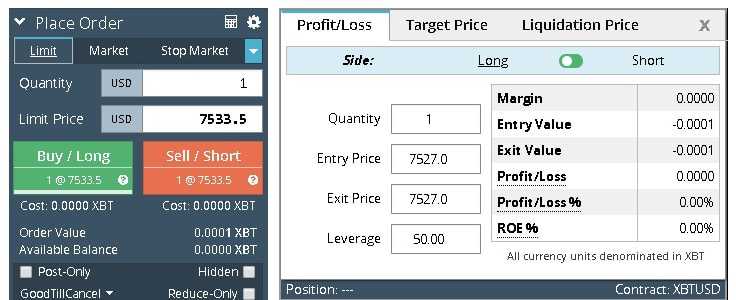
If you are a person who has ever traded on any of the other more advanced forex or stock trading platforms then these order types will be known to you. Below are the orders:
- Market Order: Order that is executed at the market rate.
- Limit Order: Order will be executed at the price that you have chosen
- Stop Limit Order: This will create a limit order that is chosen by the trader once a certain stop level is reached
- Stop Market Order: With this stop order, the order will be executed at market the moment that the stop level is reached.
- Trailing Stop Order: This can be thought of as a moving stop market order. The stop level will follow the price accounted for a spread away from market level.
- Take Profit Limit Order: This operates alot like a stop order except it is executed to close out the position to lock in gains.
- Take Profit Market Order: This works like the stop market order but in respect to locking in gains through a market order once a certain level is reached.
There are two other orders that BitMEX has in the order form that you may not have come across before. These are the Hidden and Iceberg orders that we have talked about before.
- Hidden Order: Hidden order is a limit order that is not placed on the public order books. This is used by those traders who do not want other traders to know about the positions that they are about to put on.
- Iceberg Orders: This is a variant of the hidden order where only a part of the order is displayed to the market. This is done by some traders in order to "disguise" their hidden order from certain “savvy traders”
Of course, these orders are likely to only ever be used by those really large crypto whales who’s orders are likely to have an outsized impact on the current order book.
BitMEX Liquidation Risks
For those who are familiar with BitMEX, they will know all too well the dangers of high leverage and liquidation.
When you are trading on BitMEX with up to 100x leverage, you are taking a large degree of risk on such a volatile asset. In fact, there is even a Twitter Bot that tracks BitMEX liquidations (it can get brutal)
Liquidation is what happens when the price of your position reaches the "liquidation" price level. If you ever reach this liquidation level then BitMEX will take the Maintenance Margin that you have staked and close out your position. Even if you still have the initial margin left in your account to cover your position, it will be closed if it goes past the liquidation price.
This is why it could indeed be suboptimal to such high-leverage positions on BitMEX. With lower leverage trades, BitMEX allows for your position to eat into a larger proportion of your initial margin.
For example, in this interesting analysis, the author calculated that the Maintenance Margin Requirement (MMR) is almost 50% of the initial margin when you are trading at 100x leverage whereas it is below 5% when you are trading at 10x leverage.
Warning⚠️: BitMEX is as efficient at liquidating losing positions as they are at placing your initial trades.
Hence, the analysis suggests that the maximum leverage that you should trade with at BitMEX should be no more than 25x. Moreover, if you are just starting out on the exchange, you should in any event be more prudent with the risk that you take on.
Deposits and Withdrawals
As mentioned, BitMEX is a crypto-only exchange. There are no options for funding your account with fiat currencies.
The account is funded and collateral is maintained almost exclusively in Bitcoin. Hence, you will have to send Bitcoin to your account if you want to fund it. As noted earlier, this is free.
The minimum that you can deposit is 0.001BTC and there are no limits on withdrawals. If you want to initiate a withdrawal on BitMEX, you will just select the "balances" tab from the platform and then choose the amount and the chosen wallet address.
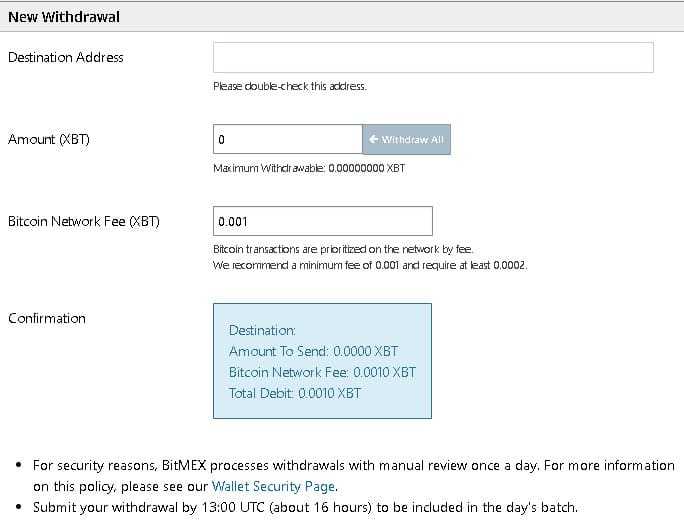
Although deposits are automated, the withdrawals are handled by hand. While this may slow down the process slightly, it is a better option in terms of security as it gives the user time to notice a suspicious withdrawal.
BitMEX Customer Support
The customer support on BitMEX is reasonable in comparison to other exchanges.
They have 24/7 support through emails and tickets. The feedback from other traders that we have been getting is that they are generally quite responsive and take about an hour or so on average.
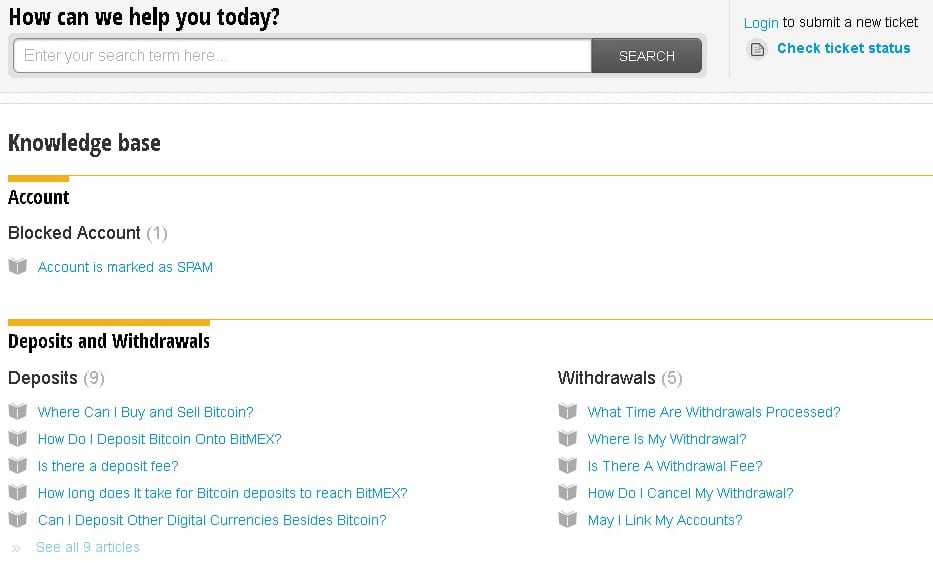
Pro Tip☎️: You can chase up a ticket on their social media channels such as Reddit and Twitter
Of course, if you are asking a more general question, you are better served to search their knowledge database. This is relatively easy to navigate and it seems that they have indeed covered all of their bases.
BitMEX API
For those traders who like to code their own bots and trading algorithms, BitMEX has a really advanced REST and Websocket API.
In fact, the API is perhaps one of the most complete on the market. Every function that is used on the website is exposed via the API. This will allow the developers a large degree of freedom when it comes to building bots and other applications.
Although the exact specifics of the BitMEX API are beyond the scope of this review, we can give you a high level guide of how to use it.
Websocket API
One of the most popular APIs for developers is the websocket one which makes use of the websocket protocol. It is highly flexible and perhaps the fastest option for those developers who merely want to get live data from the exchange.
Hence, the websocket API would be best for those developers who are building applications that make use of market data from BitMEX. Most of this information can also be accessed from the exchange with no authentication required.
This data is also not rate-limited, so once you are connected, you can get the most up-to-date information as often as you like. However, if you wanted to get information that was specific to your account then you would have to obtain authentication.
In order to do this, you would need to generate an API key in your account. You would navigate to the key generation section when logged in. You will be presented with the API key form below.
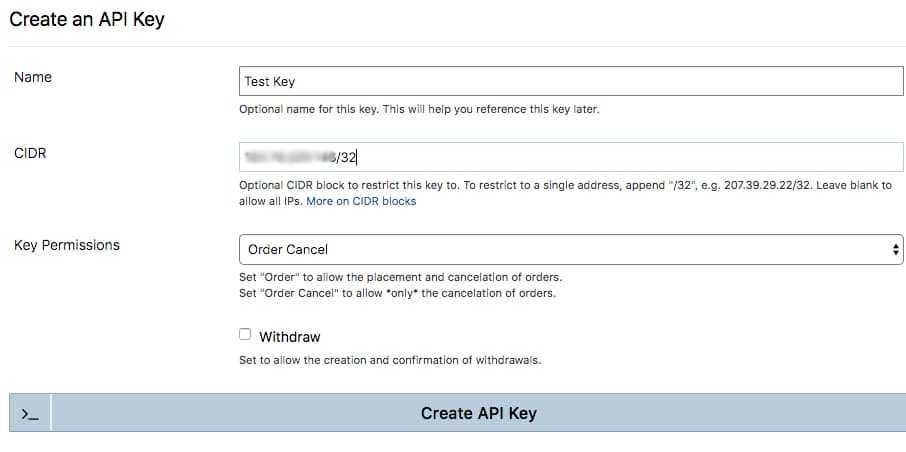
You will have to give the key a name as well as tell BitMEX what permissions you would like the key to have. You can also restrict connections with this API key to your chosen IP address. This could be a wise move in case anyone is able to somehow obtain your key. You can read more about general key usage on their API Keys Usage Page.
Once complete, you can hit the "Create API Key" button and a key will be generated for you. You can now stream account-specific information through the websocket connection. However, you cannot place any orders through the websocket. This is where BitMEX's REST API comes into play.
REST API
If you are a developer that wanted to take advantage of the full functionality of the BitMEX API, then you can make use of their REST endpoints. These include a whole host of options, such as order execution or wallet withdrawals. The latter is done without email confirmation, so be very careful with it.
If you are using the REST API, there are rate limits that will apply to your connection. You will be limited to a total of 300 requests per 5-minute period. If you are not logged in then this rate limit is set to 150 per 5 minutes.
However, if you find that these limits are too restrictive and you are running up against them then you can make a specific request by emailing the support team at BitMEX through [email protected]. There are a number of requirements your application must meet before requesting this though. You can read more about these here.
You should also be aware that BitMEX has general limits on the amount of outstanding orders as well as general order size which you can read more about in their API documentation.
Trading Chats
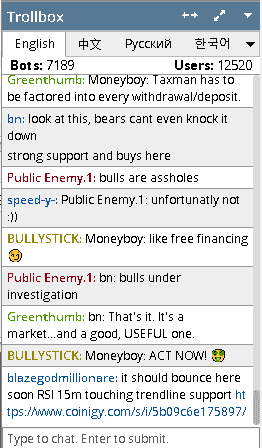
Something else that BitMEX has that is being offered by a great deal of FX platforms these days is the group chat options.
This is a pretty neat way for you to communicate with other traders and get their perspective on the market currently. This has aptly been named the BitMEX "trollbox". There are chat groups in English, Russian, Spanish, Japanese and Chinese.
In terms of the quality of the conversations, the troll box is more for well... trolling. If you wanted to get more meaningful conversations with the traders then you can join the IRC chats. BitMEX gives you the option to do that as well.
BitMEX Referral Program
If you are happy with the BitMEX trading experience and would like to refer others, then you can make use of the BitMEX referral program. With this, BitMEX gives you the opportunity to earn a commission based on the traders that you can recommend.

This is also particularly useful for those traders who command a relatively strong following online. If you refer someone to BitMEX then you will earn a percentage of the trading commissions from that individual. This will vary depending on the amount that the referral trades.
The referral program is also beneficial for those that you refer. For a period of 6 months after they have signed up, BitMEX will offer them a 10% discount on their trading fees.
Trader's Tip?: If you have followers, you can grab your affiliate tracking link and promote it on Twitter and Facebook. Commissions for you, discounts for them
If you wanted to get your referral link, all you would need to do is go to "Account & Security" and click on "Affiliate Status". Here, you will have your affiliate dashboard which will show you your link as well as other important information, such as the number of people who have signed up as well as total commissions.
There is one caveat to this though, and it is that once the affiliate has been referred, they have to complete their registration within 7 days if you want the commissions to be adequately captured. Check out the full Terms and Conditions of their affiliate program to learn more.
What We Didn't Like
While BitMEX is no doubt impressive, there are a few things that we think warrant some improvement.
Firstly, while the platform is advanced, the user interface is quite dated and things could be better laid out. For those traders who have not used advanced FX and trading platforms before, it could be quite hard to use at first.
There is also the lack of any mobile trading functionality.
While mobile trading is not for everyone, it is handy to be able to quickly monitor your positions while you are away from your PC. Of course, developing a mobile app for a platform like BitMEX's is no easy feat.
Another disadvantage, of course, is the fact that it is not open to US traders.
Now, there is nothing stopping a US trader from accessing BitMEX through the use of a VPN. Given that they do not ask for any identifying information, you can do easily do this.
Is doing so wise? Probably not.
It is against BitMEX's terms and conditions and if there is ever a situation where you will need to interact with them and they find out you are a US resident, it could only lead to more problems.
Conclusion
One thing that is clear from this review is that BitMEX is an advanced trading platform and is not for everyone.
With BitMEX, you are trading very volatile assets with leverage that can reach up to 100x. This is clearly not the type of trading for those who are new to cryptocurrencies.
You also have to be aware of the fact that you are not buying the underlying asset and are entering a derivative trade. This is not the platform that you will use for any sort of "buy and hold".
With that being said, for those traders who are familiar with margin trading and technical studies, then BitMEX is one of the best options.
They have advanced security, a responsive customer support team and a trading engine that is almost unrivalled.
If you are going to use BitMEX, make sure that you are aware of the risks that come with margin trading and of course, never risk more than you can afford to lose.
Disclaimer: These are the writer’s opinions and should not be considered investment advice. Readers should do their own research.
Disclaimer: These are the writer’s opinions and should not be considered investment advice. Readers should do their own research.


